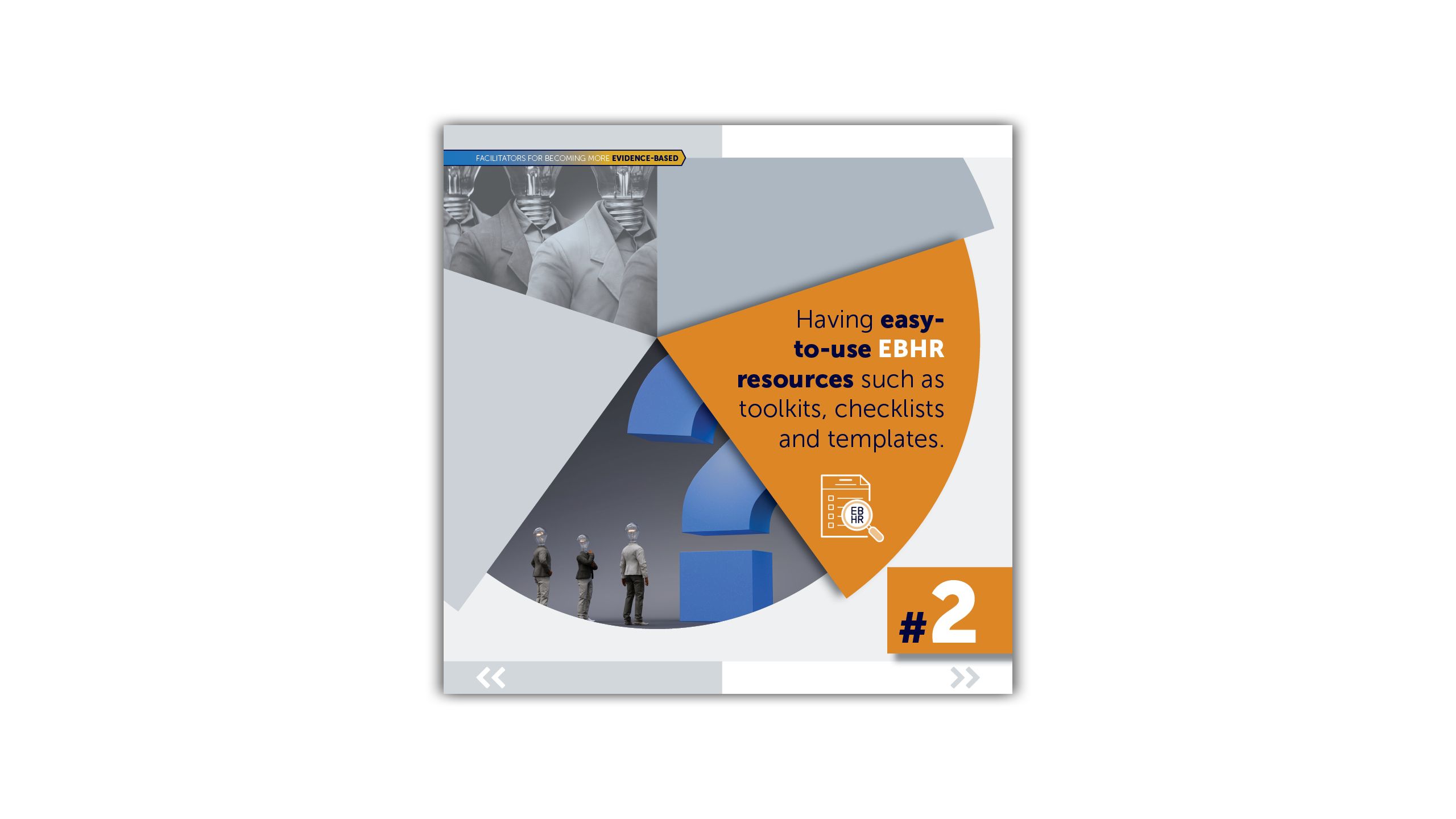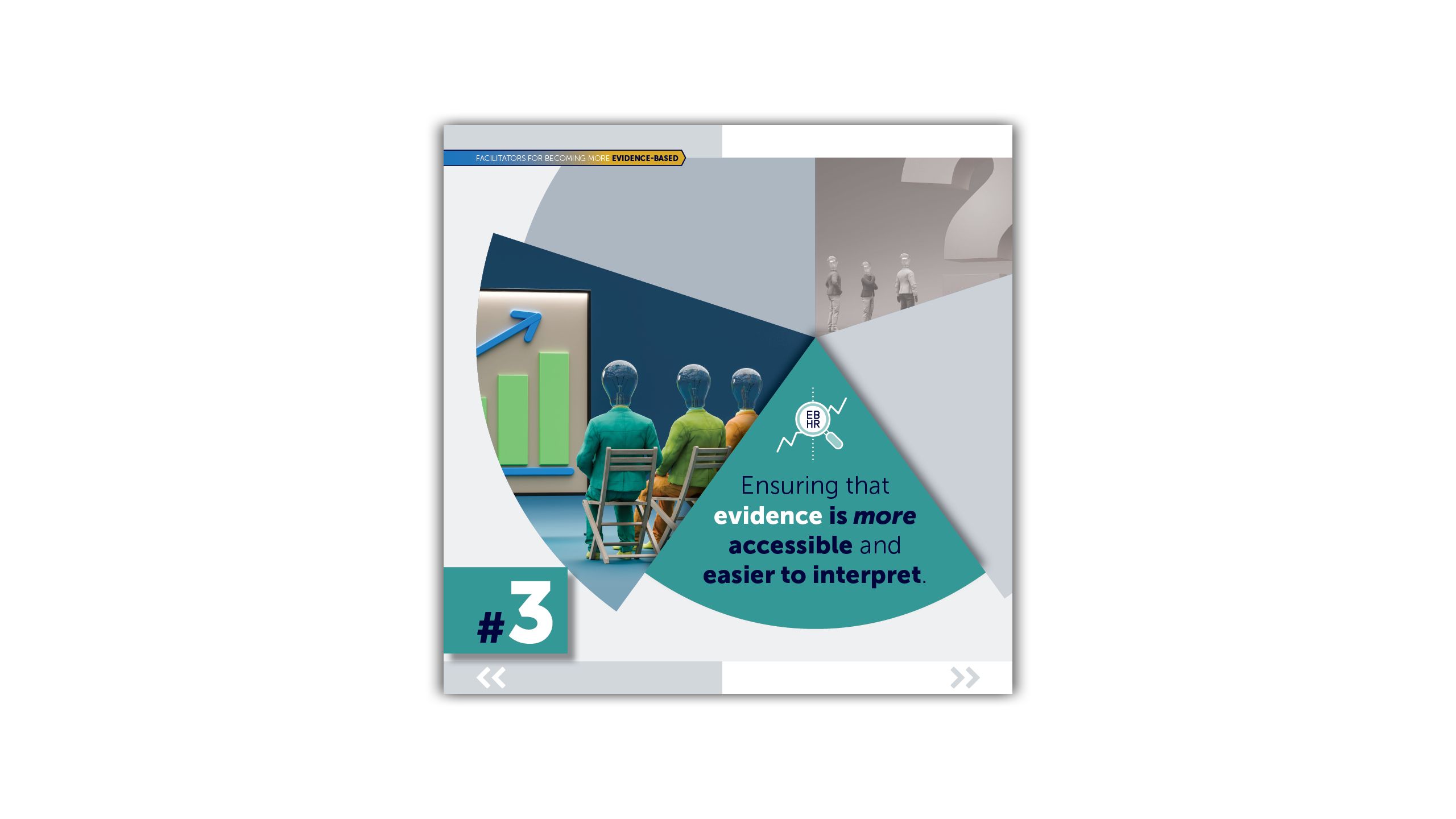KNOWLEDGE HUB
Evidence-Based HR

Welcome to CRF’s Evidence-Based HR Hub which contains information and resources to help you understand and implement EBHR in your work. The resources include: research reports, our EBHR Toolkit, articles and podcasts. If you would like any more information please contact Prof. Rob Briner.
In 2011, CRF published Evidence-based HR: From Fads to Facts? In that report, we examined what was then the relatively new idea of EBHR to better understand its meaning and relevance to the HR profession. We discussed the idea with a range of senior HR professionals and academics who first advocated its adoption.
There is no doubt that the HR function has changed significantly over the past decade. Business stakeholders have become more demanding of HR and HR has become more prominent as an internal function, a trend accelerated by the COVID-19 pandemic. Technology and the proliferation of HR analytics have played a particularly prominent role in reshaping the function.
Over the last decade, EBHR has developed in various ways, although there is still significant scope for further progression. CRF therefore decided to revisit the topic by producing two new reports. The first titled: Strong Foundations: Evidence-Based HR provides a stock take of where we are now by examining what has changed since 2011, seeking the current views and perspectives of senior HR professionals through a survey and interviews, exploring the role of people analytics within EBHR and providing some initial suggestions for how we can strengthen EBHR practice.
The second report: Evidence-Based HR: A New Paradigm considers how HR professionals and HR functions can become more evidence-based by providing a range of practical resources and detailed guidance, including a EBHR Toolkit, model, methodology and key principles for practitioners to use.
Doing EBHR
Evidence-Based HR (EBHR) supports HR practitioners to make better-informed decisions about the precise nature of the issues they face and how they can best be dealt with. It therefore plays a critical role in enhancing the HR function and helping it make a stronger contribution to the business.
Building on CRF’s 2023 research Strong Foundations: Evidence-Based HR, and discussed in the latest research Evidence-Based HR: A New Paradigm, CRF surveyed and interviewed over 200 HR practitioners to create a more detailed overview of what EBHR means in practice. As part of this, we have created a range of practical tools, collated in The EBHR Toolkit that practitioners can use to get started and maintain progress with EBHR. Read on for a preview of two of the included frameworks.


Bias Checker
We all have biases that can strongly shape the way we see things. Although it’s very difficult to remove bias completely it is possible to reflect on whether we are likely to be biased and to take steps, such as asking other people or looking for more evidence, to help reduce the impact of biases.
Thinking about how you went about the EBHR process...
answer and keep a track of your score

It is worth reflecting both individually and as a team how you scored on this Bias Checker and why. It may also be useful to ask members of the team to rate each other on these questions as well as self-rate.
Sources of Evidence Framework
Evidence-Based HR is about making better-informed decisions both about the nature of the business issues HR needs to deal with and the most likely solutions.
One of the key principles of Evidence-Based HR is to incorporate multiple sources and types of information and evidence into our decision-making. By doing so, we can build a richer and more complete picture of the evidence.
EBHR draws on four main sources of evidence. Examples of the types of evidence and information found in each source are provided in the below Framework.

STAKEHOLDER VIEWS AND PERSPECTIVES
- Executive committee
(bear in mind that strategy and objectives may not necessarily be that clear even to senior leaders) - Senior managers
- Line managers
- Employee groups and representatives
- Key employees
- Customers and clients
PROFESSIONAL EXPERTISE
- HR professionals
- Key professionals from other functions within the organisation
- External professional expertise (e.g. HR professionals in other organisations, consultants, professional bodies)
EVIDENCE FROM INSIDE THE ORGANISATION
- HR metrics and KPIs (e.g. absence, costs, training, performance)
- Surveys and employee perceptions
- Customer and client satisfaction linked to employees/teams
- Structures and processes
- Results of experiments and evaluations of HR initiatives
SCIENTIFIC AND OTHER EXTERNAL EVIDENCE
- Peer-reviewed scientific publications (e.g. meta-analyses)
- Scientific evidence collated by professional bodies and grey literature
- Benchmarking data from external research companies (e.g. salaries, practices)
- Case studies






A TIMELINE OF EVIDENCE-BASED HR
2000
Evidence-Based Practice: A Critical Appraisal – Evidence-Based Human Resource Management
Chapter in book
Rob Briner
FEB. 2007
Is HRM Evidence-Based and Does It Matter?
Institute for Employment Studies Opinion Paper
Rob Briner
OCT. 2007
Why HR Practices are Not Evidence-Based
Article in Academy of Management Journal
Edward E Lawler III
NOV. 2007
Tried and Attested
Article in CIPD’s People Management
Jane Pickard
2011
Becoming an Evidence-Based HR Practitioner
Article in Human Resource Management Journal
Denise Rousseau & Eric Barends
AUG. 2011
Evidence-Based HR: From Fads to Facts?
CRF Report
Wendy Hirsh & Rob Briner
2015
Evidence-Based HR: The Bridge Between Your People and Delivering Business Strategy
Publication of KPMG Report
KPMG
JAN. 2015
Evidence-Based HR: Under the Microscope
Article in UK HR Magazine
Katie Jacobs
SPRING 2016
The Role of Scientific Findings in Evidence-Based HR
Article in SHRM’s People + Strategy
Rob Briner & Eric Barends
DEC. 2016
In Search of the Best Available Evidence
CIPD Positioning Paper
CIPD
NOV. 2017
Make Better Decisions with Evidence-Based HR
Short article in SHRM’s HR Magazine
Shonna Walters
2018
Map Updated to Include ‘Evidence-Based’ as One of the Three Core Values of the Profession
CIPD Profession
CIPD
SEP. 2018
Evidence-Based Management: How to Use Evidence to Make Better Organizational Decisions
Book
Eric Barends & Denise Rousseau
WINTER 2019
Embracing Evidence-Based Management – The Basics of Evidence-Based Practice
Article in Special Issue of SHRM’s People + Strategy
Rob Briner
JAN. 2022
Evidence-Based HRM at Birkbeck
Launch of first ever Professional Doctorate
Birkbeck
APR. 2023
Building an Evidence-Based People Profession
CIPD relaunches and extends its online EBHR resources
CIPD
MAY 2023
Strong Foundations: Evidence-Based HR
CRF Report
Rob Briner, Nigel Guenole, Wendy Hirsh and Gillian Pillans
JAN. 2024
Evidence-Based HR: A New Paradigm
CRF Report
Rob Briner

Rob Briner, Associate Director of Research, Corporate Research Forum, Professor of Organizational Psychology, Queen Mary University of London
Three New Year's Resolutions for HR
You’d be hard-pushed to find a single HR professional who thought HR’s use of data and evidence was perfect and simply could not be improved in any way.
There is now widespread acceptance – right across the profession – that more can and needs to be done to improve our use of evidence in order to improve our effectiveness as a function and add greater value to the business.
HR's attitude towards evidence has changed
For me, this general shift in thinking towards making better-informed decisions is one of the most important changes in the profession over the past few decades.
When I first started writing and talking about Evidence-Based HR (EBHR) over 20 years ago I sensed more than a degree of defensiveness. Some practitioners seemed to feel that suggesting HR could do better when it came to evidence-based decisions was just another attack on the profession and therefore best ignored. Now, in contrast, it feels like I’m pushing at an open door when I make the same points.
But, it’s one thing to acknowledge that we should try improve the way we do something and quite another to actually do it.
What do EBHR and New Year’s resolutions have in common?
Trying to do more EBHR has much in common with classic New Year’s resolutions such as doing more exercise, losing weight or starting new hobbies. These are good things to try to accomplish. They seem relatively straightforward. It’s seems obvious what we need to do to make them happen. Yet, give it a year, and for most of us they just won’t have happened much, if at all.
These are all examples, like EBHR, of something that is highly desirable, not particularly complicated, but very hard to accomplish.
What makes EBHR difficult (though not complicated) to do and how can we make it easier?
One of the main reasons why EBHR is difficult is that within the HR profession we are just not used to making structured decisions following an explicit process of gathering and using evidence. Decisions somehow just get made. Data and evidence play a role in a somewhat haphazard way.
Adopting the EBHR model which describes the process we should ideally follow along with the four sources of evidence we can draw on, can seem too much. Particularly when we compare it to what we usually do.
It’s a bit like trying to follow a highly demanding exercise plan when we haven’t done any exercise for years. Or sticking to an all-encompassing and overwhelming diet regime when we’re used to eating whatever we want, whenever we like.
This is why breaking down broad yet desirable goals into more achievable smaller behaviours is more likely to bring about the results we want. But can we do the same for EBHR?
Can starting to do EBHR be made easier?
One way of thinking about doing EBHR is to consider its basic principles. It’s important to remember that evidence-based practice has been around for at least 30 years. These principles have evolved over time – not to help people get fitter or eat better – but to help professionals make better-informed decisions.
In our recent report, Strong Foundations: Evidence-Based HR, we define EBHR as:
“…a process which delivers better-informed and hence more accurate answers to two fundamental questions: first, which are the most important problems (or opportunities) facing the organisation which are relevant to HR activities? Second, which solutions (or interventions) are most likely to help? In other words, what’s going on and what can we do about it? These questions are answered through a combination of using the best available evidence and critical thinking.”
What are the underlying principles of EBHR and how can we start to apply them in our work?
EBHR New Year Resolution 1:
Incorporate multiple sources and types of evidence and information.
Using multiple sources and types of evidence helps us to build a more complete and accurate picture of what’s happening and what we can do about it. In EBHR we typically consider four sources of evidence, each of which includes data of quite different types.

Do we always need to use all four sources? No. But using more sources is generally better. So, if you mostly rely on one or two sources or types of evidence when making decisions, next time consider drawing on more sources and using more types.
EBHR New Year Resolution 2:
Adopt a structured and explicit process of gathering and using evidence.
There are two aspects of this structure. The first entails understanding the issue before identifying a solution. The second is about taking a structured approach to collecting the evidence we need to answer our questions.

A structured and explicit process helps us to stay on track and ensure we are systematic in gathering and applying the evidence to help us make a better-informed decision. Do you have to follow every step of this process? Not necessarily, but trying to explicitly follow the process and being aware of which steps you’re skipping is likely increase your awareness of what you know – and don’t know – and the basis on which you have identified the issue and potential intervention.
Just using one part of this process – spending much more time really trying to understand the business issue before you think about a solution – will mean you are much more likely to understand the issue and choose a solution that will help.
EBHR New Year Resolution 3:
Focus on the most trustworthy and relevant evidence.
It seems that sometimes people think that EBHR is about gathering and using all the evidence we can get hold of. The problem is that much of the evidence around us is unreliable and irrelevant so we should not use it.
This means we should pay more attention to evidence that is more trustworthy and relevant and less attention to – or even ignore – evidence that is less trustworthy and relevant.
There are many simple ways of identifying the better-quality evidence. One is to ask questions such as: Do you personally trust or believe it or not – and why? What do your colleagues think? Are there reasons to think the data may be biased or have important omissions? Are you clear about how the evidence has been collected and is being presented?
Committing and sticking to EBHR resolutions
As said at the start, you’d be hard-pushed to find a single HR professional who thought HR’s use of data and evidence was perfect and simply could not be improved in any way. Almost all of us feel we can and should do better. But how?
One way of doing this is to commit to at least trying to do more EBHR in 2024 through making and sticking to the three EBHR New Year Resolutions. At the same time, it’s essential to remember that EBHR is not about making perfect decisions but better-informed decisions. And that’s a goal that’s desirable and achievable for us all.







